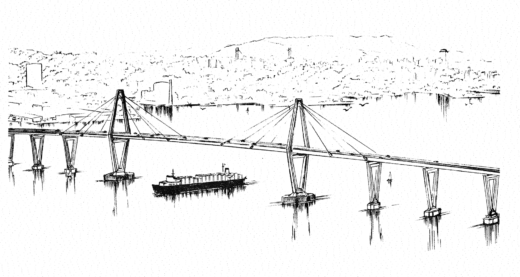If the start of planning is delayed, DeSaulnier said, regional residents will "look at 20 or 30 years of increasing congestion with no significant remedy to relieve it. That's the window of opportunity we have in the next few months."
R
egardless of whether a study recommends a second BART tube or a major new bridge, actually building it will be expensive.
A 2012 MTC study put the cost of a combined vehicle-rail bridge from Interstate 380, near San Francisco International Airport, to I-238, on the southern edge of San Leandro, at $12.4 billion. The price tag for three different alignments of a new BART tube in roughly the same area was estimated at $8.2 billion to $11.2 billion.
"We're going to have to think in a very transformational way to pay for some of these transformative but huge projects, like a second transbay rail crossing," said state Sen. Scott Wiener of San Francisco, who serves on the upper house's Transportation and Housing Committee.
Randy Rentschler, director of legislation and public affairs for the Metropolitan Transportation Commission, said the need goes well beyond one marquee project.
"We need serious money," Rentschler said. "And not just for one project such as a second crossing, but for a whole host of things that benefit not just those who are crossing the bay, but for those who are in San Jose in congestion, to benefit those who are stuck in congestion on 680 or 580 or 101 -- wherever you are."
Wiener, Rentschler and others say another reality goes along with the need for "transformational" thinking.
If Bay Area residents want big new transportation infrastructure like a new rail crossing, they'll need to be ready to foot the bill themselves.
J
ohn Grubb, chief operating officer of the Bay Area Council, a group that represents business throughout the region, says Los Angeles County offers an example of how the Bay Area might proceed. Last November, 71 percent of voters said yes to a sales tax measure that's projected to raise $120 billion for transportation over the next 40 years.
"L.A. has the worst traffic in the country, we've got the second-worst traffic in the country," Grubb said. "We need to think big."
Grubb said that the council, along with the Silicon Valley Leadership Group, the Metropolitan Transportation Commission and other planning groups, are studying whether it will be feasible to put a funding measure before voters in the nine Bay Area counties in 2020.
One possibility, Grubb said, would be a regional bond measure, which would be paid for through a parcel tax on both commercial and residential property owners.
"We've got a lot of work to do between here and there to figure out what the final mechanism would be," Grubb said. "But that is a way to raise that amount of funding in the Bay Area, for something between 75 and 100 billion dollars in transportation improvements."
The question, Grubb said, is what the electorate would support. He said initial research shows that two-thirds of voters "are willing to support even what sounds like an astounding amount of money for transportation -- that's how upset they are."
But the Bay Area Council and Silicon Valley Leadership Group say they're focusing first on passing Regional Measure 3.
"I'm going to cite the baseball maxim, 'Don't lose sight of the game you're in and start thinking about tomorrow's game,' " Carl Guardino, SVLG's president and CEO, said in an interview. "The effort we're all in now is Regional Measure 3. So while we've been working together for nearly a year and a half on what we might do in 2020, for this year we are focused on what we absolutely must do in 2018."
The MTC will hold a workshop Wednesday to discuss how much of a bridge toll increase the measure will seek and how it might be phased in if voters approve it.
